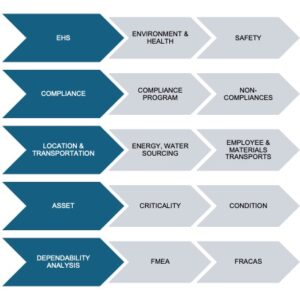Mission-critical data centres are the backbone of businesses, and it’s imperative to regularly assess and validate their energy performance, obsolescence, and dependability of the support utilities systems and subsystems. For telecom Businesses in regions across India, a comprehensive assessment of mobile switching and data centres was undertaken.
The comprehensive study mandated included the following components:

A process flow was mapped for the comprehensive performance assessment of the Data Centre.

1. A thorough assessment of the infrastructure’s environmental, health, and safety attributes.
• A detailed risk assessment based on indoor environmental test outcomes.
• Implementing risk mitigation measures, including enhancements to the clean room ventilation and filtration systems as necessary.
• A fire and life safety assessment to identify potential high risks and impacts on individuals and property.
2. Evaluation of site-specific location sustainability and transportation factors.
• Adequate space allocation for the Data Center and utilities to meet current and future requirements.
• Reliable availability of electricity and water sources to support present and anticipated needs.
• Assessment of location sustainability considering the risks from nearby fuel stations, concert halls, political establishments, and government institutions.
• Accessibility to renewable power sources for enhanced connectivity.
• Public transportation options within a 1.0 km radius of the site.
• Accessibility to skilled manpower from local communities.
3. Full-Time Employee (FTE) detailing and competency assessment:
• FTE detailing was conducted based on critical service needs.
• Comprehensive identification of competency and training needs.
4. Compliance with local and national regulatory guidelines includes reviewing compliance gaps concerning mandatory rules and regulations and risk mitigation actions taken over the past three years.
5. Evaluation of operations and maintenance services, including energy management, HVAC systems, water management, and waste management:
• Analysis of operating procedures and practices in alignment with governing standards and sustainability principles.
• Development of maintenance manuals for the operations team.
6. Energy performance assessment of the entire building and major critical systems (HVAC, electrical, and water):
• Evaluation of energy performance based on historical energy records.
• Baselining energy consumption for systems, sub-systems and the whole building.
• Spot measurements to identify the scope for efficiency improvement.
7. Creation of a short- and long-term capital investment business case for energy efficiency improvements on behalf of the client:
• Business case development for enhancing the energy efficiency of critical systems.
• Retrofit engineering solutions designed to improve energy and performance efficiency.
8. Dependability study of critical systems focusing on electrical power, HVAC, and water management:
• Assessment of reliability, availability, and maintainability.
• Obsolescence assessment.
9. Equipment condition assessment, which includes thermal scanning, power quality analysis, vibration and noise assessments:
• Evaluation of equipment age and reliability.
10. Capacity utilisation and forecasting for effective capacity management:
• Simple regression analysis of multiple variables to forecast the data centre’s most probable demand capacity for electricity, water, and waste management.
11. Functional criticality evaluation:
• Establishment of a functional criticality assessment based on Failure Mode and Effects Analysis (FMEA) tools.
12. Perform ‘Integrated System Test’ of Mechanical, Electrical, Plumbing, Lifts, HVAC, Fire Alarm and Suppression systems, Electronic surveillance and access control systems of the building and follow ‘Failure Reporting and Corrective Analysis System’ (FRACAS) procedure.
13. Development of a business case for capital investment projects aimed at improving, upgrading, and modifying systems and sub-systems:
• Submission of a capital investment project proposal for improvements, upgrades, and modifications.
Grading Asset Condition Survey and Action Priority
Preventive and Corrective or Improvement Maintenance Priorities
Priority 1
Failure or absence of critical elements has a direct impact on health and life safety.
Priority 2
Non-compliance with mandatory local and national statutory and legal requirements is identified.
Priority 3
Failure or absence of critical systems or sub-systems affects business operations.
Priority 4
Improvements or modifications in system or sub-system assets can enhance cost efficiency, service quality, and sustainability.
Critical Asset Condition Grading
Class A
The system/sub-system is fully operational and meets all design performance specifications without any issues.
Class B
The system/sub-system is functional and adheres to design performance standards. However, there are minor signs of wear or reduced efficiency at the equipment or component level.
Class C
The system/sub-system is still operational but shows significant degradation in condition or performance efficiency, deviating from the optimal design intent in several areas at the equipment or component level.
Class D
There is a serious risk of the imminent breakdown of critical element(s) running the risk of a major system breakdown.

